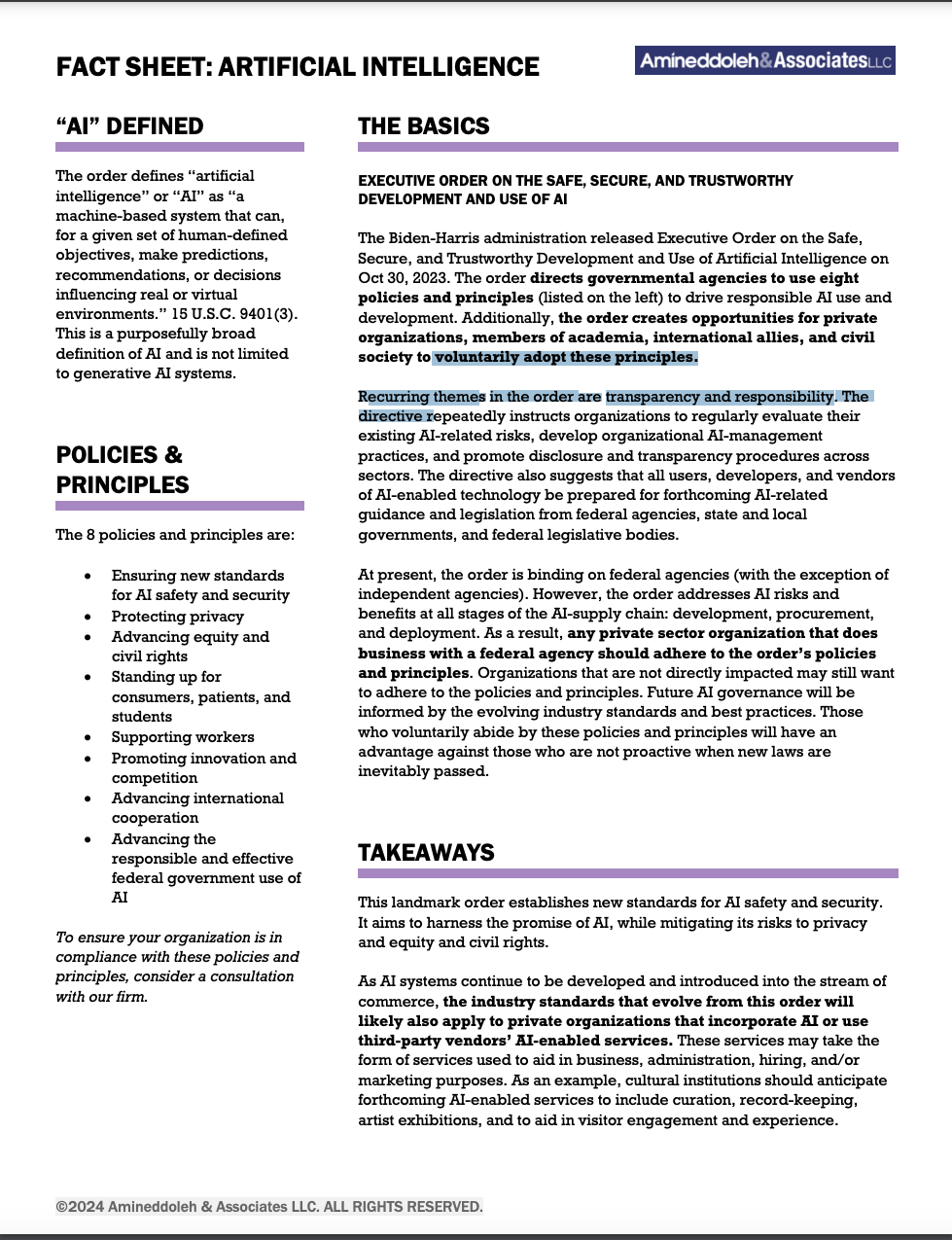Developments in artificial intelligence (“AI”) are occurring at break-neck speed; just as this technology is rapidly evolving, the law is attempting to catch up. In the summer of 2023, our founder presented a lecture on the topic of AI and intellectual property law for Holo Art Collective. Since last year’s talk, “The Future of Copyright in AI Art,” there have been a flurry of AI developments and copyright law clarifications.
According to 15 U.S. Code § 9401, artificial intelligence is a “machine-based system that can, for a given set of human-defined objectives, make predictions, recommendations or decisions influencing real or virtual environments.” 15 U.S.C. § 9401. A type of AI, generative artificial intelligence (“GAI”), is defined as “an algorithm that generates new outputs based on the data it has been trained on. … Generative AI creates new content in the form of images, text, audio, and more.” AI Terms for Legal Professionals: Understanding What Powers Legal Tech, LexisNexis Legal Insights, March 23, 2023. GAI programs like DALL-E 2, Stable Diffusion, and Midjourney allow “artists and enthusiasts to produce innumerable works of great visual interest with simple textual instructions.”
 These tools have revolutionized the way artists create. Take musical genius Paul McCartney, who used artificial intelligence to help revive the cassette audio of the late John Lennon. McCartney and Ringo Starr used this breakthrough technology to help produce The Beatles’ final song Now and Then – the band’s first release since 1995. Remarkably, Now and Then just made history as the first AI-assisted song to earn a Grammy nomination.
These tools have revolutionized the way artists create. Take musical genius Paul McCartney, who used artificial intelligence to help revive the cassette audio of the late John Lennon. McCartney and Ringo Starr used this breakthrough technology to help produce The Beatles’ final song Now and Then – the band’s first release since 1995. Remarkably, Now and Then just made history as the first AI-assisted song to earn a Grammy nomination.
However, as AI enters a new era in the world of artistic creation, it’s worth remembering that the technology also has a dark side. Most notably, AI has spurred the creation of “deepfakes” or manipulated media that creates “realistic digital impersonations, avatars, or derivative images based on pre-existing source material.” For example, a creator called “Ghostwriter” wrote and released a song called “Heart on My Sleeve” using both Drake’s and the Weeknd’s voices. To the shock of the music industry, the song was submitted to the Grammy’s this year. Recording Academy CEO Harvey Mason Jr. told The New York Times, “It’s absolutely eligible because it was written by a human.”
This argument goes to the heart of burgeoning copyright law and the use of AI for creative works. In a blow to creators of AI-generated content, the U.S. Copyright Office reversed its decision last year to protect AI creator Kristina Kashtanova’s graphic novel, Zarya of the Dawn. The text of the book was written by Kashtanova, but the images were all generated by Midjourney, a generative AI program. Although the Copyright Office initially granted registration to Kashtanova, it withdrew it after learning that the images in her book were AI-generated. According to the Copyright Office, the basis for rejection was the lack of human authorship “[A]uthorship is protected by copyright. However…the images… are not the product of human authorship.” U.S. Copyright Office Review Board, Letter Response to Previous Response Seeking Additional Copyright Information for Zarya of the Dawn Registration # VAu001480196 (Previous Correspondence ID: 1-5GB561K).
Then in August of last year, a U.S. District Court upheld the Copyright Office’s denial of registration for another AI-generated work. In 2018, Stephen Thaler applied for a copyright for an artwork created by a computer system named “Creativity Machine.” The Copyright Office denied the application because the work “lack[ed] the human authorship necessary to support a copyright claim,” noting that copyright law only extends to works created by human beings, and the work in question was created solely by Creativity Machine. Thaler v. Perlmutter, 687 F. Supp. 3d 140, 143 (D.D.C. 2023). Thaler twice requested reconsideration, but they were denied both times. Finally, Thaler challenged this decision in the U.S. District Court of the District of Columbia.

“A Recent Entrance to Paradise,” created by the Creativity Machine
As the Court stated, Thaler “attempts to complicate the issues presented by devoting a substantial portion of his briefing to the… the work-for-hire doctrine.” Id. at 145. Importantly, the Court stated, “Copyright is designed to adapt with the times. Underlying that adaptability, however, has been a consistent understanding that human creativity is the sine qua non at the core of copyrightability.” Id. at 146. The DC Circuit emphasized that even as technology evolves and provides tools to artists, a human component is essential. The court noted, “[c]opyright has never stretched so far, however, as to protect works generated by new forms of technology operating absent any guiding human hand, as the plaintiff urges here. Human authorship is a bedrock requirement of copyright.” Id. at 146.
Judge Beryl A. Howell points back to the origins of copyright law in U.S. jurisprudence. She states that the requirement is part of the “plain text” of the Copyright Act. Id. at 146. The Act protects “original works of authorship fixed in any tangible medium of expression, now known or later developed, from which they can be perceived, reproduced, or otherwise communicated, either directly or with the aid of a machine or device.” 17 U.S.C. § 102(a). The court urges that “The ‘fixing’ of the work in the tangible medium must be done ‘by or under the authority of the author.’” Thaler, 687 F. Supp. 3d at 147 (quoting 17 U.S.C. § 101).
The court found that eligibility for copyright necessitates an actual “author,” and that the author must be a human being. Thaler, 687 F. Supp. 3d at 147. As such, the Copyright Office’s rejection stands. Thaler is currently appealing the decision.
Numerous other disputes have been settled during the past year, partly due to uncertainties in the law concerning AI-generated material. One matter, Main Sequence, Ltd. et al v. Dudesy, LLC et al, 2:24CV00711, was settled between the estate of comedian George Carlin and two podcasters who purportedly used AI to create a Carlin comedy special that was aired on YouTube. As part of the settlement, the podcasters removed the material from all platforms. They also reportedly agreed to permanently stop using Carlin’s image, voice, or likeness in any future podcast without consent.
The scope of AI’s effects can be seen across most industries. Dozens of other matters have been filed, with parties including news organizations, tech companies, politicians, fashion companies, record labels, artists, and authors. Therefore, it is not surprising that government agencies, including the US Executive Office, have addressed the role of AI in the realm of intellectual property.
 As previously discussed in our blog (which includes a helpful fact sheet) earlier this year, the US President addressed AI usage. In October 2023, the Biden-Harris administration released the Executive Order on the Safe, Secure, and Trustworthy Development and Use of Artificial Intelligence. The order broadly defines “AI” as “a machine-based system that can, for a given set of human-defined objectives, make predictions, recommendations, or decisions influencing real or virtual environments.” Exec. Order No. 14110, 88 Fed. Reg. 75191 (Oct. 30, 2023) (citing 15 U.S.C. 9401(3)). It also acknowledges that the Executive Offices “places the highest urgency on governing the development and use of AI safely and responsibly.” Exec. Order No. 14110, 88 Fed. Reg. 75191 (Oct. 30, 2023). As such, the order directs government agencies to abide by eight policies and principles to advance and govern the development and use of AI.
As previously discussed in our blog (which includes a helpful fact sheet) earlier this year, the US President addressed AI usage. In October 2023, the Biden-Harris administration released the Executive Order on the Safe, Secure, and Trustworthy Development and Use of Artificial Intelligence. The order broadly defines “AI” as “a machine-based system that can, for a given set of human-defined objectives, make predictions, recommendations, or decisions influencing real or virtual environments.” Exec. Order No. 14110, 88 Fed. Reg. 75191 (Oct. 30, 2023) (citing 15 U.S.C. 9401(3)). It also acknowledges that the Executive Offices “places the highest urgency on governing the development and use of AI safely and responsibly.” Exec. Order No. 14110, 88 Fed. Reg. 75191 (Oct. 30, 2023). As such, the order directs government agencies to abide by eight policies and principles to advance and govern the development and use of AI.
The U.S. Patent and Trademark Office (“USPTO”) has also addressed the use of AI. The USPTO states on its website that it is “focused on incentivizing more innovation, inclusively and in key technology areas such as artificial intelligence (AI) and other emerging technologies (ET) …protecting that innovation and bringing it to impact to enhance our country’s economic prosperity and national security and to solve world problems.” United States Patent and Trademark Office, Artificial Intelligence, https://www.uspto.gov/initiatives/artificial-intelligence.
Importantly, the US Copyright Office addresses AI-generated works in its bulletin, Copyright Registration Guidance: Works Containing Material Generated by Artificial Intelligence. 37 C.F.R. § 202 (2023). The bulletin provides instructions on how to properly apply for works containing AI-generated material.
Even the Federal Trade Commission launched an inquiry into generative AI investments. In January 2024, the FTC announced the issuance of orders to five companies (Alphabet, Inc.,Amazon.com, Inc., Anthropic PBC, Microsoft Corp., and OpenAI, Inc.) requiring them to submit information concerning investments and partnerships involving generative AI companies and major cloud service providers. While the agency recognizes that “new technologies can create new markets and healthy competition,” the FTC also has a role in guarding against tactics that would undermine fair competition.
These concerns are not unique to the U.S. The World Intellectual Property Organization (WIPO) has long considered the effects of AI on intellectual property and has questioned whether AI innovation needs the incentives generally associated with intellectual property, and if the advent of AI necessitates changes to long-standing IP principles and frameworks.
These are questions that creators, attorneys, and governments will be grappling with during the coming years and decades, as they balance the interests of AI, the law, and ethics.